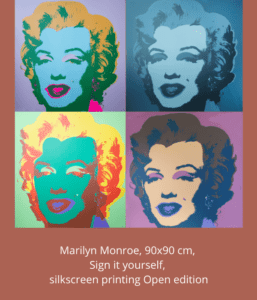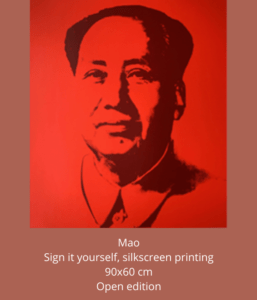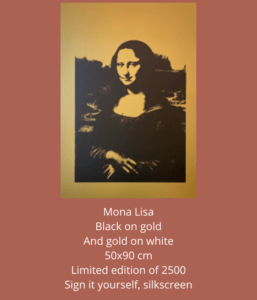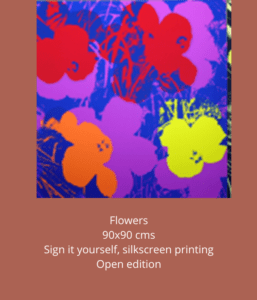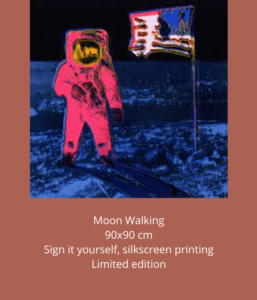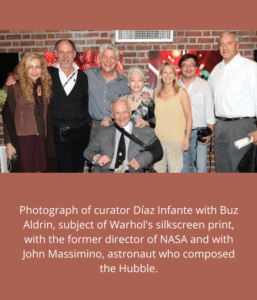My style is “life” and so is Warhol’s.
By Juan José Díaz Infante
Curator
June 29, 2022
Next June 29 comes a small exhibition of 10 Warhols to LS Gallery, but what does that mean? By an art firm called POP UP.
It’s a 15 day show, a bit experimental but they will be bringing 4 works from their Marilyn series, two of their Mona Lisas, one piece from their Flowers, two cans of Campbells and a Mao. We are negotiating the possibility of bringing Moonwalking and several LP album covers that Warhol designed as a publicist.
What does each piece mean, what does Warhol mean, what does the POP movement mean. Warhol was a publicist at the time of the genesis of advertising, that is to say the 60s, which is a decade out of series, the Moon had to be reached, Castro took Cuba and Cuba aimed missiles at the United States, there was a war in Vietnam and the hippies were shouting “love and peace”. Warhol’s work reflects all that, the Beatles, Rock and Roll, long hair, you can’t look at Warhol’s work in isolation as if life were a half-ass museum.
It’s 1962 and the world is in love with Jaqueline Kennedy, my father was also in love with Jaqueline Kennedy and, not only that, he wrote to her and she wrote back. My father was a frustrated tap dancer who could never romance the Kennedy. But everyone was the same way. It is exactly an effort of Jackie’s charisma that enables the visit of the Mona Lisa to New York, a major event of 1962, perhaps the most important art news of that year. Andy Warhol realizes the concept of “fame”, Jakie could bring the Mona Lisa to the USA, while others could not. It is that moment of enlightenment that makes Warhol make one of his first silkscreen prints, the Mona Lisa in gold and black variants. The idea, the most famous painting in the world had to be mass-produced. Andy was interested in the production of art as if it were a factory. The Factory was an art studio founded by Andy Warhol, located on the fifth floor of 231 East 47th Street, Midtown Manhattan, New York (USA). The studio operated between 1963 and 1968, when Andy moved ‘The Factory’ to the sixth floor of 33 Union Square West, near the famous club and restaurant Max’s Kansas City.
At the same time, in parallel, many stories happen, Madison, Madison Avenue in New York and David Ogilvy, a chef turned publicist, David is legendary for his advertising thinking of the 60s. Advertising was also being born. It was the quintessential creative moment. Everything was bubbling.
Andy’s idea, excessive, overflowing, like his time, never produce just one, you had to produce a lot. Advertising is that, instant and finite fame, culture interconstructed by accident. That was Warhol, if advertising in McLuhan’s words was “culture is our business”, Warhol reinterpreted the phenomenon and his business was culture. The POP movement was that the interpretation of what was happening, cause and effect. They all added up to a load of thought, McLuhan, Toffler, Kubrik, Warhol, Ogilvy, Armstrong.
The images of the sixties, the songs of the sixties, Peter Paul and Mary, fashion, Twiggy, or any comb-over, everything has the cultural charge of that time. That energy still exists in the NASA logo, the theme from 2001 Space Odyssey (never mind that it’s by Strauss) or the logo of the Mexico Olympics.
Andy Warhol created the Factory where his silkscreen prints were mass-produced. While someone was doing a silkscreen, someone else was shooting a movie. Every day something new was happening.
When Warhol was working on his work, silkscreens and lithographs were mass-produced as was the custom of the big factories made to satisfy the public with their consumer products. He himself became a consumer product. Warhol was a party, leading a group of porn stars, of course some drug addicts, not missing a couple of drag queens, musicians and freethinker partners and associates, who voluntarily and involuntarily would be part of his paintings, act in his films and create the atmosphere that turned the Factory into a legend.
The Factory was a collection of outrageous parties frequented by hipsters with artistic pretensions, eccentric bohemians and amphetamine users. Warhol chose the Warlhol Superstars, whom he promoted for a certain period of time until he named the next Superstar, that’s where his philosophy was born, which assured that in the future we would all have fifteen minutes of fame.
This coming June 29th he invites us for a few hours to a space where you can feel the burden of what we are talking about in a silkscreen that will touch a little bit of your soul. The series of works on display are editions of Sunday B Morning, another Warhol experiment that is founded and established in Belgium, is associated with two new anonymous characters, a mystery, Warhol provides Sunday B Morning with the negatives of his own hand to continue editing the concept of silkscreen as a work of art, as an object of consumption and that can give the democratic sense of art. The second edition of the classic Marilyn Monroe series is edited with Sunday B Morning and now the fourth edition. This edition is characterized from the second by the stamp on the back, the second edition is black stamp and edition 4 is a blue stamp.
This same issue is used today for Warhol exhibitions around the world, as due to its price to product ratio, it makes large exhibitions possible without the need to pay excessive insurance and handling fees. This exhibition is a unique event in CDMX and promises to be a unique experience due to its unique curatorial concept.




